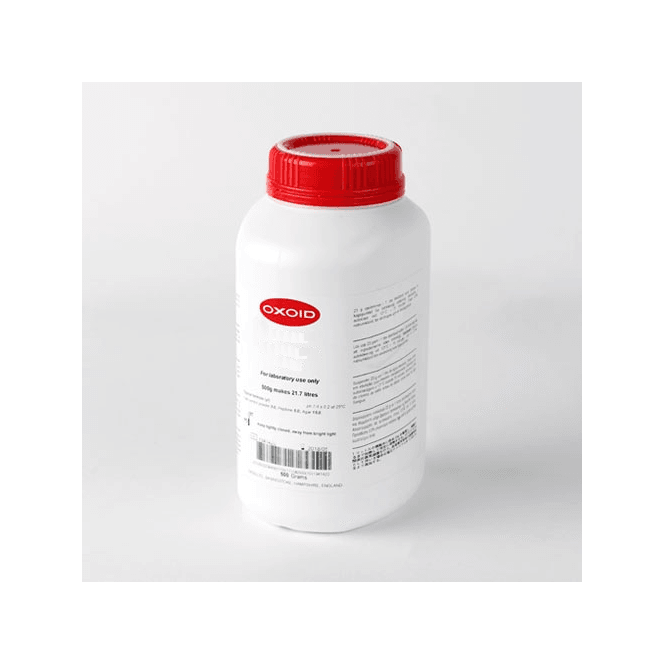Thermo Scientific™ Oxoid™ Azide Dextrose Broth (Dehydrated)
Catalog No :
CAS Number :
Brand :
In Stock
Specifications:
| Application | Microbiology | ||
| Storage Temperature | Room Temperature | ||
| Product Type | Culture Medium | Forms | Powder |
| Product Brand | Oxoid | ||
| Product Grade | Microbiology grade | ||
Thermo Scientific™ Oxoid™ Azide Dextrose Broth (Dehydrated) is a selective culture medium specifically designed for the detection and quantitative determination of enterococci in water, sewage, foods, and other materials potentially contaminated with sewage. It utilizes sodium azide to suppress Gram-negative organisms, providing optimal growth conditions for enterococci. The medium's balanced nutrient profile, pH buffering system, and selective properties make it ideal for use in environmental microbiology and public health testing.
Key Features
- Selective Growth: Sodium azide inhibits Gram-negative organisms while allowing the selective enrichment of enterococci.
- Highly Nutritious: Peptone and dextrose in the medium provide essential nutrients for enterococci growth.
- pH Stability: A phosphate buffer system maintains a stable pH, ensuring reliable results across a variety of sample types.
- Versatile Applications: Recommended for detecting enterococci in water, sewage, foods, and other materials suspected of contamination.
- High Yield: One package (500 g) prepares up to 14.0L of medium, making it cost-effective for high-volume testing.
Specifications
| Attribute | Details |
|---|---|
| Type | Dehydrated Culture Media |
| Form | Powder |
| Description | Azide Dextrose Broth |
| Selective Agent | Sodium Azide |
| Target Organisms | Enterococci |
| Yield | 14.0L of medium per 500g package |
| Unit Size | Each |
| Applications | Water and sewage testing, food safety |
Applications
1. Environmental Microbiology
- Water Testing: Detect enterococci as indicators of fecal contamination in drinking water, recreational water, and wastewater.
- Sewage Analysis: Monitor sewage contamination levels in environmental samples.
2. Food Microbiology
- Food Safety Testing: Detect enterococci contamination in foods to ensure compliance with health standards.
3. Public Health Monitoring
- Assess the presence of enterococci in chlorinated waters as a more robust indicator of fecal contamination compared to Escherichia coli.
Advantages
- Selective Enrichment: Sodium azide suppresses competing Gram-negative flora, allowing precise detection of enterococci.
- Reliable Indicators: Enterococci are better indicators of fecal contamination in chlorinated waters due to their resistance to chlorine.
- Broad Utility: Applicable to water, sewage, and food samples, making it versatile for various testing needs.
- Cost-Effective: High yield of 14.0L per 500g package, suitable for large-scale testing.
Preparation Instructions
- Weigh the Medium: Suspend 35.7 g of the dehydrated powder in 1 liter of distilled water.
- Mix and Dissolve: Heat gently while stirring until completely dissolved.
- Sterilize: Autoclave at 121°C for 15 minutes.
- Cool and Dispense: Allow to cool to 45–50°C, then dispense into sterile containers or test tubes.
Organisms and Testing
| Target Organism | Significance |
|---|---|
| Enterococci | Indicators of fecal contamination |
| Gram-Negative Flora | Suppressed by sodium azide |
Storage and Stability
- Storage: Store in a cool, dry environment at 10–30°C in its original container.
- Shelf Life: Refer to the product label for expiration date and usage guidelines.
General References
- Mallmann W. L. and Seligmann E. B. (1950). Am. J. Public Health, 40: 286.
- Edwards S. J. (1933). J. Comp. Path. Therap., 46: 211.
- Hartman G. (1937). Milchw. Forsch., 18: 166.
- Greenberg A. E. et al. (1998). Standard Methods for the Examination of Water and Wastewater, 20th Ed., APHA, Washington, D.C.
Packaging
- Product: Azide Dextrose Broth (Dehydrated)
- Quantity: 500g
- Yield: 14.0L of prepared medium
The Thermo Scientific™ Oxoid™ Azide Dextrose Broth (Dehydrated) is a reliable and effective medium for detecting enterococci in environmental and food samples. Its selective properties, robust nutrient composition, and high yield make it indispensable for laboratories focused on public health, environmental monitoring, and food safety testing.




 0
0
